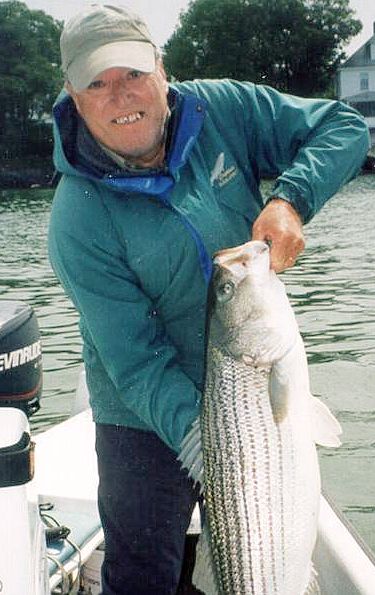

Stoat leaders while fly fishing for striped bass has been the rule so far during the 2010 season. Average size of striped bass has been running between 28 and 34 inches with an occasional larger fish. These are fish from the Chesapeake Bay 2003 year class which had a good young of the year index.
The above photo is of a late 2010 June fish caught in Maine waters. We are catching a lot of fish this size in 2010.
The blue-black herring run lasted into July, so the larger stripers really put on the weight. Because there has not been a lot of surface action and the numbers of striped bass are still low, anglers seemed to give up on stripers this year. Even on weekends there haven’t been many fishermen on my waters. In reality, striped bass fishing has been pretty good in comparison to the past three years.
August and September promises to be good for those willing to put in the time. Mackerel, pollack and crustaceans of crabs and shrimp will be prime attractions to stripers during the late season. Flies, lures and baits matching those attractions will put fish on the hook.
But just a reminder, Maine’s keeper size for striped bass remains a slot of 20 to 26 inches or one fish over 40 inches. I’ve seen too many people keeping fish over 26 inches. This outlaw activity is likely a result of frustration from not finding any fish in the slot size. There just aren’t many fish in the slot size available from Maine to South Carolina. That’s the problem for the next few years.
Another outlaw practice I am seeing more of is high grading. This meaning that an angler catches a keeper size fish, puts it on a stringer over the side in the water and hopes to catch a larger fish to replace the one already caught. Just a reminder, that practice is illegal. Some people go as far as to kill a keeper and then throw it away after catching a large slot fish. Some of those striped bass you see floating dead are most likely victims of the disgusting practice.
If you catch a Maine striped bass measuring from 24 to 26 inches, please consider releasing it as there is a high probability it is a Kennebec River born fish which will become a sustaining spawning fish if left to live. We tried to get a law passed to truncate Maine’s slot limit to one fish at 20 to 24 inches for the next two years to protect these valuable spawners, but couldn’t get it done. There doesn’t seem to be any will to help Maine’s Kennebec River striped bass stock which had a dominant 2006 young of the year class which are the fish just coming into the 24 plus inch range this year. It’s a shame the state didn’t try to protect these future spawners of the Kennebec River.
Another volunteer action you can do to help the future of striped bass in Maine is to use in-line circle hooks while using bait.
Using fly head wraps (shown above) in the Carrie Stevens style to identify flies that have extra weight and/or a rattle is useful. Orange wrap indicates the fly has a rattle. Both colors indicate extra weight and a rattle in the same fly. No colored wrap indicates no extra weight or rattle.
As of the first of July, pogies nor blue fish have arrived in my waters.
Fishing striped bass in Maine and on Cape Cod has been much better this season for larger fish but not for numbers. Bait is in ample supply for a good late season.

